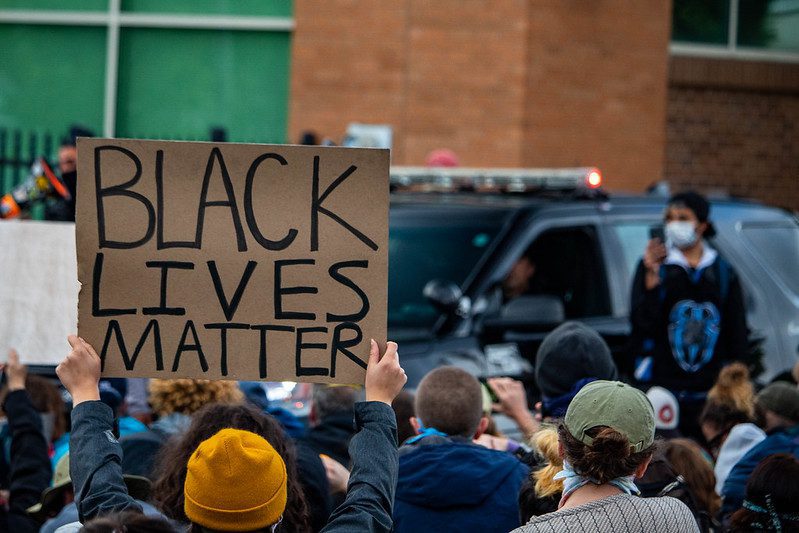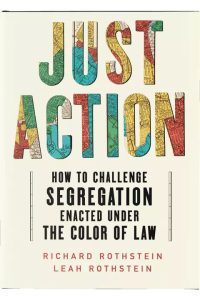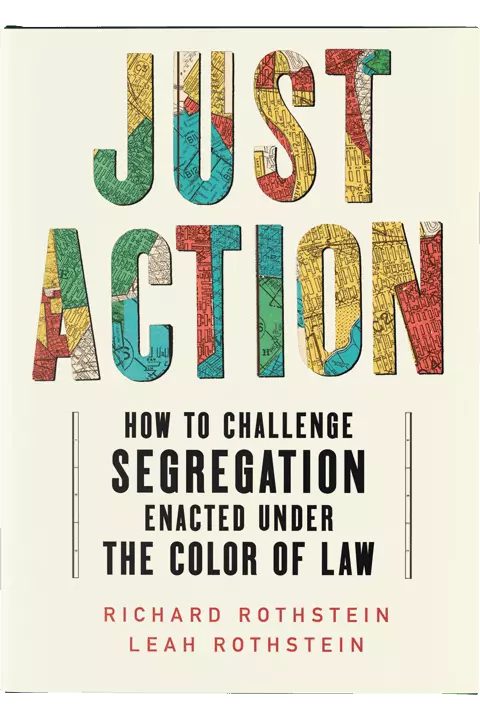
A June 2020 Black Lives Matter march in Oregon. Photo by Flickr user David Geitgey Sierralupe, CC BY 2.0

This interview was conducted live by Anne Price, with follow-up questions from Price and Miriam Axel-Lute (marked “Shelterforce”) answered by both authors in writing. It has been edited for length and clarity.

Richard Rothstein: We don’t think that there is the political climate now in this country to enact national race-conscious programs of any kind, but we think they are actually constitutionally required because the racial segregation that we have in this country was created unconstitutionally by federal, state, local governments in violation of the 13th and 14th amendments in particular. Even though there’s no national political will for it, we think that we can make progress by organizing a new civil rights movement at the local level to create local pressure to enact remedies for segregation and its effects.
We don’t think that simply throwing out policy ideas is very helpful at this point. We know what to do, and policy experts throw out ideas all the time. What’s missing is an activated base of people. We begin the book Just Action by alluding to the fact that 20 million Americans participated in Black Lives Matter demonstrations in 2020, the largest mobilization of racial justice supporters in American history and also the most diverse. Many of those demonstrations were in white suburbs. The participants were Blacks and whites and Hispanics [and] others, young and old, urban and suburban.
Then when those demonstrations were over, the participants went home, and most of them put Black Lives Matter signs on their lawns and then went about their business and did nothing to make Black lives matter. We think that those people are a base of support for local activists to build a movement for race-conscious remedies. That means subsidies to African Americans for housing. It means taking account of race in zoning issues, in the assignment of new housing developments, in the creation of mixed-race housing in all kinds of communities.
Although [our book] seems like it’s filled with policy ideas, we don’t think the ideas enact themselves. The underlying theme of the book is that we need local organized committees, biracial committees, because African Americans can’t solve these problems without political support from the white community.

Photo by Michelle Poulin
Leah Rothstein: In terms of what will be most impactful, we present in Just Action dozens of policies and strategies that local groups could take on and advocate for in their own communities. We don’t presume to know which one will be most impactful for each community. Every community is different, with its own unique opportunities and challenges and history. What will be most impactful is just getting started with any one of them for whichever one is the most appropriate for your community.
Shelterforce: You speak about organizing a “new civil rights movement” as if there were a vacuum of racial justice organizing happening in the country. How do you think that local multiracial anti-segregation work could interact with and respect existing racial justice organizing and be connected together to be an actual movement?
We use the term “new” civil rights movement only in answering “frequently asked questions” at the end of the book. In the main text we refer to a “re-invigorated civil rights movement.” We credit the local groups that are doing racial justice organizing and we argue that, in order to achieve significant gains in the redress of segregation, many more people, Black and white, urban and suburban, will need to join these racial justice groups and collaborate with them to work on the strategies we outline in Just Action.
We describe how groups can begin by building relationships across races, to form biracial, multiethnic committees that can advocate for policies and programs to redress segregation locally. A part of forming these committees includes members not only learning the history of how their community came to be segregated, but also understanding the organizations in their area working on these issues. They should connect with these organizations and support their campaigns, when appropriate. Or they can start their own campaigns and invite support from existing groups. Through this collaboration, local groups can begin to form a movement.
Whether newly organized biracial and multiethnic community groups should support the work of existing racial justice organizations will have to be determined by those committees on a case-by-case basis. While many activities of existing racial justice groups are worthy of support, some may not be. For example, there are existing tenant organizations that are mobilizing to protect tenants from unjust evictions. Such activities are worthy of support. There are other existing racial justice groups whose focus is on removing symbols of segregation, like changing street names or striking out restrictive covenants from home deeds. Such activities may not be worthy of support if they are not connected to campaigns that actually create new and better housing opportunities for Black families.
At both the local and national levels, to be successful, a re-invigorated civil rights movement must be biracial and multiethnic. Leadership by African Americans is necessary, but also essential is active involvement by whites, middle-class whites in particular, organized for action in their own communities, as well as in support of movements for racial justice in predominantly Black and Hispanic communities.
Anne Price: We’re looking at localities embarking on reparations approaches. We saw this in Evanston [Illinois] with their housing restorative program. We’re seeing it here in the state of California, over in San Francisco, with the reparations group and a dreams initiative focused on housing also with the state task force. Do you feel that these types of approaches can center the needs of Black Americans but also educate white Americans around why these disparities exist?
Leah Rothstein: We don’t use the word “reparations” in our book. We prefer “remedies.” I think there’s a danger with calling a program that addresses one piece of racial disparities and racial inequities a reparations program. [It] runs the risk of thinking that once we’ve implemented that program, we’re done repairing all of the harm that has been caused by racially discriminatory policies and unconstitutional policies.
I’m heartened by all of the conversations that are happening about reparations. I think it’s an important step to normalize that it’s our responsibility, our constitutional obligation to repair these harms. How we do it is then the next subject of debate.
Richard Rothstein: Another reason why we focus on remedies rather than reparations is reparations is most often vaguely associated with reparations for slavery. Slavery was horrific. It was inhumane. It was obscene. No words can describe it, but it was constitutional in this country. [Had] the 13th and 14th amendments been implemented, the vestiges and the effects of slavery would’ve been wiped out. We would’ve had a racially egalitarian society.
[For] every one of the policies that were unconstitutionally implemented after the 13th and 14th amendments were passed, you can calculate specific remedies for those clearly unconstitutional policies. There’s no vague reference to the fact that the people were enslaved; there were specific policies that we can name and that I identified in The Color of Law that created the inequality that we have today.
Shelterforce: Throughout history, many immoral things that deserve redress were legal at the times they happened. Your focus on crafting remedies to things that can be said to have been illegal or unconstitutional at the time they happened is clearly intentional, and clearly a strategic rather than a moral choice. Can you explain the reasoning behind that focus?
It is a legal argument, as well as a motivational one. We do not accept that the current Supreme Court is correct [about] what is legal and constitutional. That’s why our focus throughout the book is remedial action for the unconstitutional and unlawful practices of government and private actors subsequent to the adoption of the 13th and 14th amendments to the Constitution.
The original Constitution tolerated slavery. The amended Constitution is the most radically democratic and egalitarian document in world history. We should take advantage of it.
Anne Price: You state that changing minds is not a movement, that it’s more important to take action to redress segregation than to eliminate implicit bias.
I think that cognitive scientists would have us believe otherwise. They often talk about our mental models. The narratives that we hold so near and dear shape our ability to pass certain policies. They shape what kind of solutions are even put on the table. Housing markets reflect what we see as valuable. They are shaped by race, specifically by anti-Black racism.
We’re living with a perception that Black people lower property values. How will we be able to implement solutions that you propose in the book if we don’t address these underlying beliefs?
Richard Rothstein: Well, obviously, it’s a circular issue. People’s stereotypes are based on their observations and their stereotypes reinforce those observations. We place much more emphasis on what people do than what they feel. Throughout the 20th century, African Americans were discriminatorily imprisoned, and still are. Many whites who don’t think deeply about these things see African Americans imprisoned and conclude that African Americans are a criminal class.
Because of the housing policies that we implemented, African Americans were herded into overcrowded communities. They couldn’t maintain buildings in the same condition as were maintained in white neighborhoods. Garbage collection, for example, was less frequent in Black neighborhoods. People were doubled and tripled, so their social life moved out into the streets. Whites who don’t understand these things saw those characteristics and assumed that African Americans who moved into their neighborhoods would bring with them those characteristics.
The best way to change those stereotypes is to provide adequate housing options for African Americans, to stop imprisoning on a discriminatory basis young African American men. Social psychologists find that when white people observe African Americans in a subservient condition, they conclude that African Americans are a subservient class. If they observe African Americans not in a subservient condition, they begin to think of African Americans as their equals. Obviously, one reinforces the other, but making progress in real conditions will itself change people’s implicit biases.
I’ve seen the slogan that “some of my best friends are Black.” Well, they develop more best friends who are Black and they begin to think of Blacks as their equals. If they don’t have any friends who are Black, it’s hard for them to change their implicit bias.
Leah Rothstein: We advocate in Just Action for forming biracial groups locally to begin to work on these issues. To create effective biracial groups, whites and African Americans have to address their implicit biases. It is an important step in the process. We can’t expect people of different races to want to work together if they’re going to be subjected to microaggressions and colleagues who are unconscious about the biases that they’re reflecting.
We also argue that just addressing our own internal biases won’t change the conditions of our communities.
Shelterforce: The Color of Law was very much about the structural causes of the racial disparities in homeownership, wealth, and where people live. Just Action refers to this sometimes, as in when you suggest going after corporations that benefited from harms to Black people. In other cases it suggests more individual-focused remedies. These may be necessary because individuals were harmed and undoing the causes doesn’t always repair the harm, but sometimes it can lead to the implication that individual deficits are the problem.
Do you recommend that people read Color of Law first to make sure they are grounded in the understanding that these disparities have structural roots? How would you suggest framing campaigns for remedies like race-conscious downpayment assistance to keep the narrative focus on the structural reasons such programs are needed?
We don’t agree that Just Action in any way implies that “individual deficits” are the problem. However, it remains true that, given the subordinate condition into which unconstitutional and illegal actions have forced African Americans, they must continue to “work twice as hard to accomplish half as much.” We do not regard African Americans to be the passive recipients of remedial policies. While we don’t consider those who cannot be activists to have “deficits,” we do think that individual as well as collective action is necessary for a reinvigorated civil rights movement to be successful. To truly redress segregation, we must address both the communitywide causes and individual consequences of this system.
For example, the homeownership rate for African Americans is barely half that of whites. One reason for this is that African Americans have less access to inherited wealth to use for downpayments than whites, due to unconstitutional past policies and practices that prohibited African Americans from homeownership when homes were affordable. To remedy this homeownership gap, we recommend both system reforms, like changing the credit scoring system to be less disadvantageous to African Americans, and programs that offer individual assistance like downpayment subsidies and homeownership education to Black potential homebuyers.
Both systemwide and individual actions are necessary to remedy past harms and create a more equitable system today. Understanding the past policies that have created and maintained today’s inequities is important to understanding why both approaches are essential.
Certainly, we think that readers of The Color of Law will have a greater appreciation for the necessity of the policies and programs that Just Action describes. We hope that people will read both. But The Color of Law is not a prerequisite for Just Action. We do summarize the argument of The Color of Law at the beginning of Just Action.
Shelterforce: In a section at the end you explain some of your word choices as a desire to be welcoming and accessible to people who may not be comfortable or familiar with racial justice terminology and might be turned off by buzzwords or unexpected capitalizations. This is a good goal, but at times it felt like the pendulum swung the other way, digging in on phrasings or sentiments that were similarly likely to be off-putting to progressives, such as telling Black people it was in fact their job to keep educating white people about racism. Did you take any steps to review your wording and commentary to make sure it was also welcoming to readers who were left-leaning, Black, and/or existing racial justice advocates?
We thought about this very carefully and put a lot of thought into how to make this book accessible to a broad audience, not only to those that are already well-versed in issues and discussions of race and racial justice.
To build a successful movement, one cannot employ different language for different people. It was never a good idea, but in today’s online world, you will get caught and people will mistrust you if they find you are speaking to them differently from how you speak to others. It is the job of all those, Black and white, who have a more sophisticated understanding of racial inequality to explain it to others, Black and white, whose understanding is less sophisticated. To be successful in this endeavor, those who are more sophisticated have an obligation to consistently use language that brings into their tent those who are less so. That has always been the first rule of effective social justice organizers and remains so.
After completing a draft of the book, we asked almost two dozen individuals to review it and provide feedback and comments. These reviewers included Blacks and whites who are housing policy experts and advocates, racial justice organizers, civil rights leaders, and members of local organizing groups working on housing and racial justice issues. We considered all of their comments seriously and made several revisions based on their reactions, including around the language we employed. [Editor’s note: Miriam Axel-Lute was one of the reviewers.]
Anne Price: Obviously, this is a book really focused on segregation. We know that segregation laid the foundation for current exploitive practices. In the “Stop the Fraud” chapter, you illustrate one form of extraction, contract leasing, which has defined Black homeownership for many years and has really thwarted wealth building. What are some of the actions that will have the greatest impact dismantling this and other forms of fraud and extraction and help communities be able to begin to build wealth?
Richard Rothstein: Actions begin small and build up. One of the things we do in the chapter to which you refer is identify the banks, the developers, the Realtors who financed the exploitation, and we identify [their] successors today, because many of those that participated in contract selling in the mid-20th century have been absorbed by larger institutions. When they absorb these smaller banks and Realtors and developers, they absorb not only their financial liabilities, but their moral liabilities as well. These institutions should be particular targets for campaigns.
We write in the book about a photographer in Chicago who has identified the homes in her Englewood neighborhood that were sold on contract, [thereby robbing] African Americans of the ability to save and to own property. She’s put plaques in front of those homes. Her next step is to develop the political support to demand of the city of Chicago that similar plaques be placed in front of the banks downtown that have inherited the obligation to redress this.
There are many, many private actors that contributed to segregation, and they all are potential targets of action.
Leah Rothstein: We could [also] advocate for policy change on the local or state level that regulates these kinds of agreements, that makes them adhere to terms like mortgages.
Also, many families who end up in contract-selling situations do so because they can’t access traditional mortgages. We can work to address the obstacles to African American families getting traditional mortgages. One way of doing that is to reform the credit scoring system so that the type of financial history that African American households are more likely to have, like rental payment history, utility bill payment history, are factored into a credit score.
Or local banks could adopt special-purpose credit programs that could target mortgage products to African Americans in their communities that have been the victim of past or current racial discrimination in the financial sector. We can get at this issue in a lot of different angles.
Richard Rothstein: I want to make clear, when she says advocate, she doesn’t mean write letters or write op-eds. What she means is organizing people going door to door, creating grassroots groups. We get lots of ideas of things that should be done. What we need is organizers who are going to take those ideas and mobilize people to actually campaign to put them into effect.
Anne Price: Yes, most definitely. It is going to take movement building to build power and demand change.
What excited you all in terms of some of the ideas that you’re seeing advocates and movement-building grassroots groups push for right now?
Leah Rothstein: I don’t know if I can pick one. Writing this book has been a very hopeful experience for me. We’ve talked to urban, rural, Rust Belt, coastal cities, and there’s movement around these issues everywhere. Even in communities that you would think don’t want to address their history of exclusion, [that] they’re happy the way they are pricing out everybody but the most affluent—there’s people in those communities also who are organizing to make their communities more inclusive. That’s been really exciting to me.
Richard Rothstein: Associated with this book, Leah and I have started a regular Substack column. In May, Leah posted about an all-white rich community in the South Bay of San Francisco, Menlo Park, that organized a committee. They went door to door to mobilize people in support of a racially open community.
They eventually, to their surprise, succeeded in defeating a referendum that would’ve prohibited the development of other than single-family homes in the community for any purpose. The school district can’t keep teachers because no teachers can afford to live in the community. The school district took some empty property and proposed to build housing for teachers and the NIMBYs opposed it.
This group didn’t campaign based on economics or law. They explicitly campaigned by recruiting people to the idea of a racially diverse community, and they succeeded, to their surprise. That excited me.
What excited me in the book is in Winston-Salem, North Carolina, there are six Presbyterian churches, three all-white, three all-Black. Because of a bunch of racial incidents, the ministers of those churches decided to get together and create something called a Presbyterian interracial dialogue. They all brought their implicit biases with them, but they nonetheless forced the community to adopt and maintain a civilian review board. They insisted on the inclusion of African-American history in local school curriculum. Then they built Habitat for Humanity Homes to provide housing for low-income Black families in the community.
In every community in the country, there are Black and white churches that have very little to do with each other, and they could join together to multiply their power enormously.
Anne Price: There’s probably no bigger issue in terms of how people think about why we have such a large racial wealth gap than housing. Housing is seen as both the cause and the solution.
We know government policies of the past really enabled white homeowners to build wealth and pass it on to future generations. We know that Black people aren’t facing that same condition today.
Something I challenge people on in this space is this assumption that homeownership has the same financial impact for Black people as it does for white people. We know that homes in majority Black neighborhoods are devalued. Andre Perry from Brookings has really done a great job in showing this devaluation, which is somewhere around $48,000 per home per year.
Should we actually think about homeownership differently? Remove it from being this singular important investment that families need to make to ensure they have the trajectory to build wealth, given this perception that when you have Black people in your neighborhoods, they lower values? That’s not something we’ve been able to truly overcome. What are your thoughts on homeownership as this driver, and talk a little bit about what you outlined in your book to combat some of the issues around homeownership.
Leah Rothstein: Homeownership is not a panacea, because of all of the reasons you mentioned. When the Federal Housing Administration subsidized the suburbanization of America for white families, those homes were affordable—$100,000 in today’s money. You can’t buy a home in any suburb that I know of for $100,000 today. Buying into homes now will not generate the same amount of wealth. It’s not a promise that it was for previous generations.
Just getting into homeownership likely won’t address the entire wealth gap. [However,] it is worth our attention to allow African American families who want into homeownership to more easily be able to access that. We talk about the credit scoring system, special purpose credit programs, downpayment assistance programs. Other programs we talk about are homeownership education and counseling, expanding the program that does allow housing authorities to use Section 8 for homeownership. There’s all these little fixes that can address the greater issue.
Richard Rothstein: The wealth gap is attributable to unconstitutional discriminatory housing policy, but the fact that that’s how it was created doesn’t mean that that’s how it can be solved. Unfortunately, most of the solutions to the wealth gap are federal. The purpose of Just Action is to describe how local activity can build ultimately to a national movement, but we’re not there yet.
The most important way to address the wealth gap is to help people save money. An inadequate health insurance program is a big problem. Pension reform is another one. These are all national policies, not things that we can begin locally.
There are other benefits of homeownership besides the accumulation of wealth. People who own their homes are more invested in their communities. They’re more likely to vote. They’re more likely to participate in the governance of their local schools. It’s not a panacea, but it’s a good thing for us to support. It’s not in itself going to solve the wealth gap.
We cannot significantly address homeownership opportunities for African Americans without substantial financial support, not just downpayment assistance of a token amount, but subsidies from the major institutions that created these gaps in the first place. That requires direct action against the banks and the real estate firms and the developers.
We have many examples in the book. One of them is Charlottesville, Virginia. There is an enterprising journalist who identified the restrictive covenants that blanketed Charlottesville’s white neighborhoods. He picked a few, and they list the developer, bank, [or] Realtor who created a community on a segregated basis. One of them was Robert E. Lee Construction Company. After the Black Lives Matter demonstrations of 2020, it decided to change its name. It’s now just the Lee construction company.
That company should be the focus of direct action by local groups to subsidize African Americans to purchase homes in Charlottesville from which that company in particular excluded them when these communities were built.
Anne Price: I want to interrogate something you say in the book that really struck me personally. You claim that Black people have unfounded romanticism about the success of segregation in the early and mid-20th century. You go on and give statistics to show why this isn’t the case. Immediately for me, it really brought up my own family’s history, my mother’s stories about both the hardship, but also the joys that she experienced and her ancestors experienced during segregation.
Of course segregation was terrible in so many ways, but it allowed other types of wealth to be formed. It allowed Black people to be invested in the success and excellence of their children. Black teachers, for example, who were really invested in the learning of Black children. When integration occurred, many of those teachers were pushed out of teaching and were replaced oftentimes with white teachers who didn’t have the same credentials, if they had any at all.
Segregation allowed for the creation of mutual aid, societies, fraternities, and sororities, and cultural institutions. I think what Black people actually may romanticize or crave is the freedom to truly be themselves without the white gaze or without white people dampening their spirit and their joy. These are realities that may not be fully understood or even valued by white people, but they are the basis of how communities have actually thrived.
I would say it’s really important that Black people be believed and trusted with their own stories, with their core truths, and to know that Black people are more than their struggle.
Richard Rothstein: I don’t think we said that Black people have a romanticism about segregation. We said that some do, and we were quoting letters that I’ve certainly received of people who oppose actions to improve Black communities from fear that if the communities are improved, whites will try to move in, gentrification will take place. What we say is that you can’t have it both ways.
This is obviously a complicated issue. You’re absolutely right. There were many benefits to living in a homogeneous Black community and still are, but there’s a big price to be paid.
There are organizations that represent African Americans or Hispanics today that oppose improvements in their community because they’re afraid that if the community is improved that they will no longer be an ethnically homogenous group. They’re paying a big price for that. Not that there wasn’t a benefit to it, but the benefit in our view doesn’t outweigh the price that’s being paid by maintaining low-income concentrated communities that don’t have the same opportunities that people have in other communities.
When we talk about romanticism, we’re talking about some people who don’t want to acknowledge that there is a trade-off.
Leah Rothstein: Yes. Everyone should have the right and the opportunity to decide how they want to deal with that trade-off and choose what community they want to live in. Whites should listen to African Americans when they say what they want and what kinds of communities they want. We’re advocating for there to be choice. Not that African Americans should be limited by what communities they can live in. If they want to live in majority African American communities, great. If they want to live in communities that are more exclusive and have historically excluded them, those should be open to them as well.
Shelterforce: A danger in centering your fight for racial justice on integration is that you can reinforce a negative narrative that white people are necessary to have a healthy or functional neighborhood. How might we pursue redress for the harms of legally created segregation without reinforcing the idea that a neighborhood that is primarily Black is inherently bad?
We do not regard primarily Black neighborhoods as inherently bad. But neighborhoods without adequate resources, well-financed schools, clean air, affordable and well-maintained housing, opportunity to access jobs, freedom from police abuse, and a diverse social class distribution are not healthy neighborhoods or places where people should be forced (because other choices are not offered) to raise their children.
Ethnic and racial clusters, freely chosen and with adequate resources, should be available to all. Segregated neighborhoods have not been freely chosen.
Just Action makes clear that redress of segregation requires both additional resource investments in segregated neighborhoods (“place-based” programs) and opportunity to live in more highly resourced neighborhoods (“mobility” programs).
We do note, however, that when a low-income segregated neighborhood becomes better-resourced, families with greater resources, of all races and ethnicities, will choose to move there as well. The aspiration is not realistic for a formerly segregated but now well-resourced neighborhood to remain racially and culturally homogeneous. We do, however, emphasize policies that can prevent displacement of many (though not all) lower-income residents who have historically lived in such economically improving neighborhoods.
Anne Price: Thank you.







Question: why is historic redlining and segregation limited to the African American experience? I dare say that if American cities & towns were governed by non-white elected officials, we still would be experiencing forms of economic segregation due to the fact that “minority” policymakers have adopted the same economic ideologies they (we) inherited.
We never discuss, much less analyze, the critical role of economic policymaking at the local level, impacts which are consequential, transformative, and virtually irreversible. The ubiquitous “urban planning” model has yet to account for itself in this regard.
In my city of San Antonio, Tx, this assertion is a case study to my argument. We, too, suffered from “historic redlining”, as a majority-Hispanic population. A federal lawsuit in the late 70s forced us to elect “minority” representatives using a 10-1 districting format; since then, “minorities” have had a clear policymaking majority, yet, we have emerged to become the nation’s most impoverished urban city & ranking nationally in economic segregation. So-called “historic redlining” has had nothing to do with our socioeconomic conditions. We do not account for our own policymaking impacts and outcomes.
Therefore, we do need to update our views & conclusions from the traditional take-aways re: “historical redlining” analysis. A national perspective would be advisable.